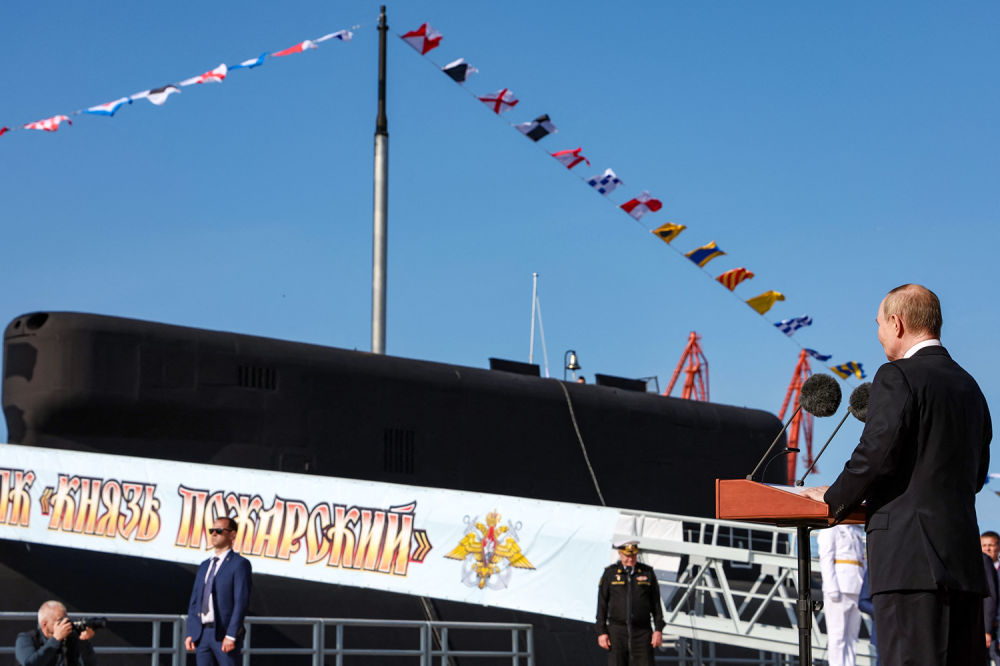In recent days, many a tear has been shed for the Admiral Kuznetsov, Russia’s only aircraft carrier. After a long and unlucky life, the ship has endured a retrofit so ill-fated that it’s now about to be scrapped. But don’t feel too smug about Russia’s soon-to-be carrier-less navy because it’s expanding its already fearsome submarine fleet instead.
Lately, even news outlets that rarely report on military equipment have run big headlines about the Admiral Kuznetsov, a Soviet-built ship that has been Russia’s only aircraft carrier for 40 years. Over 1,000 feet long and with a range of 9,800 miles, the ship was a serviceable design from the late 1980s but always behind the times compared to its U.S. counterparts.
But the Admiral Kuznetsov has had so many mishaps that people have begun feeling sorry for it. There were canceled deployments, repairs, and a lot of idle years. When the ship finally participated in a combat deployment, sailing to Syria in support of Syrian President Bashar al-Assad in 2016, it lost two aircraft.
In 2017, the aging ship was sent to Murmansk for repairs and a retrofit, a process that has dragged on and on. The following year, the dry dock in which the ship was being repaired sank. The year after that, a major fire erupted on board, killing at least one person and injuring 10. In 2021, the director of one of the ship repair plants was arrested on suspicion of embezzling money earmarked for the repairs.
The Maritime Executive reported that Russia’s 2022 invasion of Ukraine cut off “its supply chain for Soviet-compatible marine engines and spares—a niche that Ukrainian factories had filled for Russia’s navy since the communist era.” Then another fire broke out on board the Admiral Kuznetsov in December 2022. And now comes the news that the ship may be scrapped altogether. All this evokes memories of the hapless and Russian-guided missile cruiser Moskva, which Ukraine dramatically sank in the Black Sea in 2022.
But any snickering at the Russian Navy would be sorely misplaced. “The Russian navy does not need aircraft carriers in the classic form,” said Sergei Avakyants, a former commander of Russia’s Pacific Fleet. “The aircraft carrier is already a part of a bygone era. [It is] a huge, expensive structure that can be destroyed in a few minutes with modern weapons.”
Russia has long recognized that it is not able to compete with the United States’ carrier battle groups. Over the past several years, it has instead been busy expanding its already respectable submarine fleet—taking a distinct stance in the long-running debate over whether or not carriers are inherently obsolete in an era of missiles and stealth submarines. Submarines, with their inherent stealth capabilities, have often been the choice of the weaker side; the German Navy couldn’t take on the British Royal Navy in 1917 or 1940, but it could deploy submarines to try and wreck British ships.
Russia introduced 13 new submarines to its Pacific Fleet between 2013 and 2025, including five Borei-class vessels that are nuclear-powered. “The Russians are not going to invade America,” said John Aitken, a veteran submariner who was a commodore and deputy director submarines in the British Royal Navy until last year. “But what they might do is invade Europe, or part of Europe, or a European country.” Submarines, Aitken explained, could allow Russia to threaten carrier-defended U.S. battle groups in the absence of effective fleets.
This may not be a cutting-edge strategy, but the Kremlin appears to be fully invested. In July, Russian President Vladimir Putin called the submarine expansion “crucial” and highlighted the future acquisition of four more Borei-class vessels. But the submarines have uses far beyond thwarting U.S. naval deployments to Europe, and unlike the ill-fated Admiral Kuznetsov, they see regular use.
In June, one of them sailed through the North Sea and the English Channel. “The Russians are looking at the Arctic and elsewhere at the same time they’re looking at the North Atlantic,” Aitken said. “And it’s not just their nuclear boats. The latest batch of Kilos are very capable, and they have some in the Black Sea, they have some in the Baltic Sea, and they have some in the Barents Sea. We’ve seen a huge upswing in the amount of activity by the Russian forces all along Russia’s Arctic coast.” Putin delivered his pro-submarine speech in Severodvinsk, where the latest Borei-class submarine is being commissioned.
Submarines are in vogue. Right now, the United States, Europe, and Russia all have fleets that are around the same size—but they’re all looking to expand. NATO member states have recognized where maritime warfare and deterrence are headed. In June, the United Kingdom announced that it plans to acquire up to 12 new attack submarines, a dramatic increase from the Royal Navy’s current fleet of nine. Another two are going to enter service in 2026, including one that was delayed following a major fire in the shipyard at Barrow-in-Furness.
Germany commissioned six new submarines to be built—two for itself and four for Norway—in a rare case of successful joint procurement. Sweden has ordered two. Australia struck a critical submarine deal with the United States and the U.K. in 2021, though it is now threatened by the Trump administration. But because weapons orders are a multiyear process, it will be years before the submarines get a chance to protect NATO waters.
The primary task for Russian submarines today is testing their own abilities and reconnoitering those of NATO. But their use could get a lot more aggressive—and determining just what Putin’s plans are is the responsibility of Western politicians, naval officers, and intelligence analysts. Russia’s record at sea has always been weak for a power of its size, from the destruction of its fleet by the Japanese at the Battle of Tsushima in 1905, to Ukraine sinking the Moskva in 2022. But it’s still a threat, and the asymmetric power of submarines makes it a real challenger to U.S. strength.
The post Russia’s Submarine Plans Are Bad News for the West appeared first on Foreign Policy.




